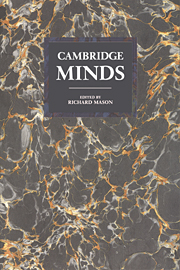Book contents
- Frontmatter
- Contents
- Notes on contributors
- Preface
- 1 The effects of a broken home: Bertrand Russell and Cambridge
- 2 I. A. Richards, F. R. Leavis and Cambridge English
- 3 Emily Davies, the Sidgwicks and the education of women in Cambridge
- 4 Radioastronomy in Cambridge
- 5 Three Cambridge prehistorians
- 6 John Maynard Keynes
- 7 Mathematics in Cambridge and beyond
- 8 James Stuart: engineering, philanthropy and radical politics
- 9 The Darwins in Cambridge
- 10 How the Burgess Shale came to Cambridge; and what happened
- 11 Ludwig Wittgenstein
- 12 ‘Brains in their fingertips’: physics at the Cavendish Laboratory 1880–1940
- 13 J. N. Figgis and the history of political thought in Cambridge
- 14 Molecular biology in Cambridge
- 15 James Frazer and Cambridge anthropology
- 16 Michael Oakeshott
4 - Radioastronomy in Cambridge
Published online by Cambridge University Press: 21 October 2009
- Frontmatter
- Contents
- Notes on contributors
- Preface
- 1 The effects of a broken home: Bertrand Russell and Cambridge
- 2 I. A. Richards, F. R. Leavis and Cambridge English
- 3 Emily Davies, the Sidgwicks and the education of women in Cambridge
- 4 Radioastronomy in Cambridge
- 5 Three Cambridge prehistorians
- 6 John Maynard Keynes
- 7 Mathematics in Cambridge and beyond
- 8 James Stuart: engineering, philanthropy and radical politics
- 9 The Darwins in Cambridge
- 10 How the Burgess Shale came to Cambridge; and what happened
- 11 Ludwig Wittgenstein
- 12 ‘Brains in their fingertips’: physics at the Cavendish Laboratory 1880–1940
- 13 J. N. Figgis and the history of political thought in Cambridge
- 14 Molecular biology in Cambridge
- 15 James Frazer and Cambridge anthropology
- 16 Michael Oakeshott
Summary
One of the most exciting aspects of modern science has been our growing understanding of the structure of the Universe and how it has evolved since the beginning of time. Scientific books do not usually rank amongst the best-sellers, but the outstanding success of Stephen Hawking's famous book A Brief History of Time shows how this subject has captured the popular imagination. To a large extent our present picture has come about through discoveries in radioastronomy in which Cambridge has played a leading role. In this chapter I shall sketch a few highlights of the Cambridge work.
The beginnings of radioastronomy in England were stimulated by the wartime discovery of radio waves emitted by the Sun. In the dark days of February 1942, shortly after the German warships Scharnhorst and Gneisenau had made their dash to base through the English Channel, anti-aircraft radar stations experienced severe jamming signals. At first assumed to be enemy activity, it was later found by J. S. Hey, engaged in operational research, that the signals came from the Sun's direction and were associated with an active sunspot, also seen by optical astronomers at the Royal Observatory, Greenwich. Systematic investigation of this unexpected type of solar radiation was an obvious choice for a university research group in radiophysics starting up again after the war.
- Type
- Chapter
- Information
- Cambridge Minds , pp. 48 - 57Publisher: Cambridge University PressPrint publication year: 1994

